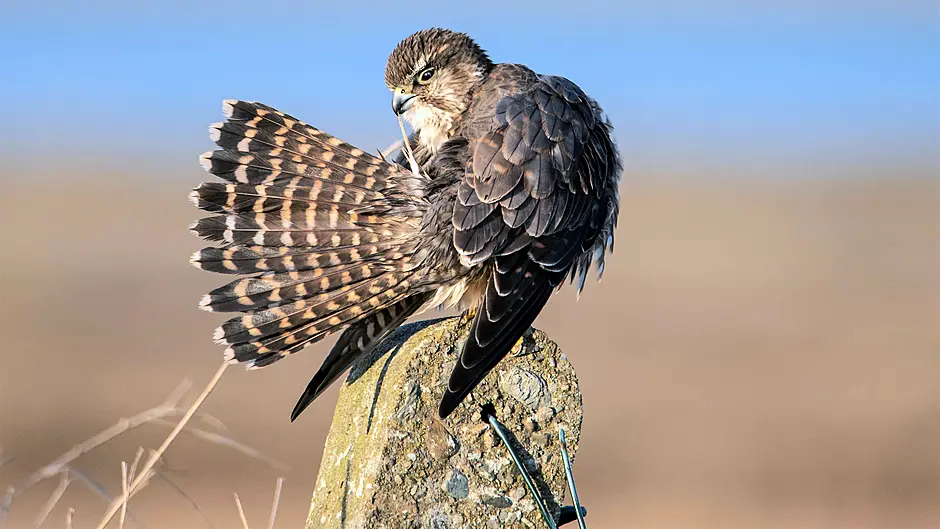I HAD a truly magical encounter one morning recently when I saw one of Ireland’s scarcest birds just metres from my own front door.
A rapid flight caught my eye as a bird launched itself from a telephone pole and skimmed over the adjacent field at warp speed.
And a second glance at its raptor profile and diminutive size soon confirmed it to be one of West Cork’s most elusive birds – the merlin.
Fearless hunter
The merlin is Ireland’s smallest hunting bird and is distinctive in many ways. Larger raptors, such as buzzards and kestrels, search for prey in a high soaring flight. But the merlin lives and hunts in the lowest band of air space just a few feet above the ground.
The speed of the merlin is remarkable to witness, as it pivots and turns in this limited space. And its miniscule size makes it easy to differentiate from that other agile hunter, the sparrowhawk.
As is the case with most raptors, the male of this species is much smaller than the female.
A male merlin is no bigger than a mistle thrush, with a slate grey back and wings. The female merlin is noticeably larger and heavier than the male, weighing in at around 210g (7.5 oz). Her plumage is more uniformly brown so she could be confused with a female kestrel.
For such a small bird, the merlin consumes an impressive amount of food. A single individual has been known to kill and eat more than two birds a day.
It has to eat so much because it expends a lot of energy hunting as its strike rate is not particularly good, with only 5-15% of its hunts ending in a successful kill.
Skylarks, meadow pipits and other small birds are frequently predated upon by merlin on the wing but small mammals also provide added sustenance. In summer, merlin also feeds on the plentiful supply of day-flying moths, as well as dragonflies and other large winged insects. This fearless hunter will also attack larger birds too from time to time, even up to the size of a lapwing.
Rarely seen
Merlins are northern birds, inhabitants of latitudes and altitudes beyond the tree line. They occur throughout Eurasia and North America and Ireland and UK mark their most southerly breeding grounds.
While we do have this beautiful bird as a scarce breeder here, its remote breeding locations mean it’s rarely seen. However, in wintertime our residents are joined by migrants from Iceland. The Irish birds join these ‘blow-ins’ to feast along our West Cork coast, where I had my recent sighting.
On the open hillsides, the merlin has a very strong affinity with heather. This could be because heather provides good cover for nesting and has an ample supply of meadow pipits. However, some bogland and moorland without heather has even higher populations of pipits but they are ignored as breeding grounds. So the heather does really hold an attraction for merlins.
Another unusual association is between nesting pairs of merlins and hen harriers. Some merlin pairs choose to nest in close proximity to the much larger hen harriers and the reason for this is not clearly understood. But it is possible the smaller bird gains some protection from proximity to the bigger raptor.
This small hunter is no match for other, large birds of prey and merlins are often attacked by peregrines. So it’s possible nesting that so close to the larger hen harrier (who does not attack merlins) may offer it some protection.
Along with most other raptors, merlin populations collapsed due to the widespread use of DDT and other pesticides in times past but their numbers are slowly recovering now across Europe.
However, according to a recent study by the National Parks and Wildlife Service, over 70% of recorded raptor deaths in Ireland are due to poisoning, so this danger is still present today. The loss of breeding habitats is another major threat to our Irish birds and one that may be a more difficult problem to solve in the long term.
So keep your eyes peeled around our West Cork coast and, like me, you may be blessed with a merlin sighting this winter.






